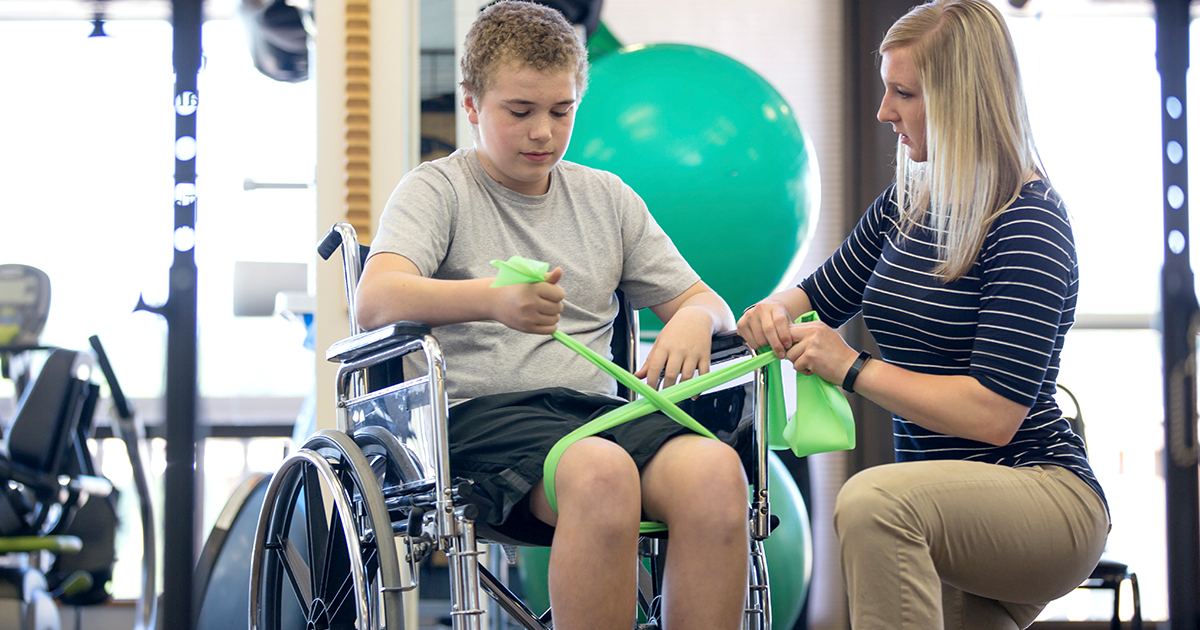Iconic Symptoms Of Different Types Of Muscular Dystrophy
Muscular dystrophy, commonly known as MD, is a category of genetic diseases that lead to progressing muscle weakness and atrophy. Each type is caused by a gene mutation that affects certain proteins that help with healthy muscle development. Not all of the genes have been isolated. Because there are multiple subtypes, the symptoms and progression vary widely. Some types show symptoms in adulthood, while the most common begin showing symptoms in childhood. Some types have a shortened life expectancy, while others include a normal or mostly-normal life expectancy. The quality of life also varies depending on what muscle groups are affected. Different types have different common symptoms. It's important to be aware of how different symptoms present when isolating the subtype and determining treatment.
Waddling Gait

A waddling gait is one of the hallmark symptoms of Duchenne muscular dystrophy (DMD). This is the most common subtype and tends to present with symptoms in childhood. Medical professionals refer to this type of gait as a Trendelenburg gait. A Trendelenburg gait is caused by weakness in the hip muscles, and while it can be a sign of multiple subtypes of muscular dystrophy, but it isn't always. Other conditions that can cause a Trendelenburg gait are nerve damage, osteoarthritis, cleidocranial dysostosis, and poliomyelitis. When the patient takes a step, the hip on the side of the leg that's swinging will drop rather than staying in place. It's also common for patients to counteract this hip dipping by bending their torso toward their other side, which further exacerbates the waddling effect. A similar waddle can sometimes be caused by orthopedic conditions rather than hip muscle weakness, and it might be observed after an injury to the glutes or hips. Regardless of whether the gait is related to DMD or not, it should be evaluated by a doctor.
Read about the next iconic symptom now.
Inability To Relax Muscles At Will

Myotonic dystrophy is one of the many subtypes of muscular dystrophy, and it is characterized most strongly by the inability to relax muscles at will. Other subtypes also include an inability to relax the muscles, but myotonic dystrophy is the only type with this as the hallmark symptom. Myotonic dystrophy affects both the muscles and varying organ systems throughout the body. Myotonic is an adjective form of myotonia, which is the medical term for an inability to relax the muscles. Like other forms of muscular dystrophy, myotonic dystrophy includes progressive shrinking and weakness of the muscles. There are two types of myotonic dystrophy: type 1, the most severe, and type 2, a less severe form. Both are caused by different genes. myotonic dystrophy is among the most common subtypes of adult-onset muscular dystrophy, and it is the most common among adults with European ancestry. It's rare for non-white populations to have occurrences of myotonic dystrophy. The myotonia presents in a variety of ways. One example is a patient might have trouble releasing another's hand after they shake it.
Uncover details on the next iconic symptom now.
Muscle Weakness

Muscle weakness is one of the main symptoms found in all subtypes of muscular dystrophy. Every form of muscular dystrophy includes progressive weakening of the muscles and muscle atrophy. However, the groups of muscles affected vary from case to case. Most individuals with muscular dystrophy experience symptoms in their legs that lead to a decrease in stamina. They may at first need supportive mobility devices like braces, and then will progress to needing a wheelchair. Some muscular dystrophy patients might be able to walk short distances or stand for very brief periods, while others may not be able to walk at all. Muscle weakness also causes complications throughout the body. If the muscles in the abdomen weaken, there can be trouble exhaling. Weakness in the diaphragm makes it difficult to inhale. Additional weakness in the nose and throat can further complicate breathing. In addition, the heart often becomes progressively weaker. When muscular dystrophy shortens an individual's lifespan, the cause of death is often cardiac-related because of heart damage.
Get more information on additional iconic symptoms linked to types of muscular dystrophy now.
Frequent Falls

Frequent falls are a common sign of muscular dystrophy. They're best known as part of Duchenne muscular dystrophy, but other subtypes can also include frequent falls. When a child with DMD is first showing symptoms, they may fall over more than other children their age, often without any apparent warning. Symptoms tend to occur early in childhood, and some parents might overlook them as a normal part of learning to move around. If a child is falling frequently enough to make their parents concerned for their safety, they should talk to their doctor.
Another subtype of muscular dystrophy that can include frequent falls is Becker muscular dystrophy. This is a less severe form of Duchenne muscular dystrophy, so the symptoms appear later. Typically, patients start seeing issues like increased falls between eleven and twenty-five years old. Myotonic dystrophy might cause falls due to muscle rigidity, but it usually affects the face and neck before the legs. Limb-girdle muscular dystrophy can also cause frequent falls because an affected individual struggles to lift their foot fully, which leads to tripping.
Discover more iconic symptoms of muscular dystrophy now.
Walking On The Toes

Walking on the toes is one of the hallmark signs of Duchenne muscular dystrophy, and it can also occur in Becker muscular dystrophy. In addition, patients with limb-girdle muscular dystrophy sometimes experience difficulty lifting the front of their foot from the ground. This leads to both tripping and toe-walking. In the case of Duchenne and Becker muscular dystrophy patients, the toe-walking is because of the way the disease affects the legs. Many patients experience contractures in their feet that lead to a shortening of the tendons, limiting the range of motion of their ankles. When they stand, they aren't able to put their foot flat on the ground because their ankle can't bend that far. Some contractures can be helped through surgery, but they're likely to recur since the disease is progressive.
Read more about the symptoms of various forms of muscular dystrophy now.
Difficulty Standing

The most common form of muscular dystrophy known to produce difficulty standing is referred to as Duchenne muscular dystrophy. An individual affected by this form of muscular dystrophy may experience frequent falls when attempting to stand, have trouble standing when going from a sitting or lying position, problems running and jumping, a waddling gait, muscle pain and stiffness, learning disabilities, large calve muscles, and walking on the toes. Individuals with another form of muscular dystrophy referred to as Becker muscular dystrophy may also experience difficulty with the action of standing. The most common muscles to be affected by weakness and a decrease in mass that produce problems with standing in an individual affected by muscular dystrophy include the glutes, quadriceps, and hamstrings.
Get more details on the major indicators of muscular dystrophy now.
Large Calf Muscles

Muscular dystrophy occurs when an individual's body does not make a protein referred to as dystrophin. Dystrophin is a protein that protects the muscle fibers by providing stable structural support. The muscles of an individual affected by muscular dystrophy become damaged when they contract due to this lack of protection and support. The body reacts to this muscle fiber damage by repairing the tissue and replacing it with dense and fibrous scar tissue. The body also replaces broken down muscular tissue with excess adipose tissue. The scar tissue, connective tissue, and adipose tissue tend to accumulate on the calf muscles being broken down in an affected individual, which causes them to develop abnormally large calves despite the lack of muscle in the area.
Learn more about the iconic symptoms of muscular dystrophy now.
Foot Drop

Drop foot and foot drop are terms used to describe when an individual experiences an inability to lift the front part of their foot. An individual affected by foot drop may drag their toes on the ground when they are walking, or they may lift their knees to a higher than normal position when walking to avoid dragging their toes on the ground. Some individuals affected by foot drop will swing their legs in an arc to keep their toes from dragging on the ground as they are walking. A muscular dystrophy patient may experience problems with the muscles in the foot responsible for lifting the front of the foot when walking. When the muscle fibers in these muscles become damaged and subsequently repaired by scar tissue, the muscle will not be able to contract and relax properly. This impairment can result in foot drop.
Continue reading to reveal additional symptoms of muscular dystrophy now.
Scoliosis

Scoliosis is known to develop in between seventy-five and ninety percent of Duchenne muscular dystrophy patients. Scoliosis that develops in an individual affected by muscular dystrophy tends to progress more rapidly than scoliosis caused by other factors. Lumber and thoracolumbar curves are the most common features seen in individuals who have developed muscular dystrophy-precipitated scoliosis. Scoliosis from muscular dystrophy can also produce thoracic kyphosis, pelvic obliquity, and lumbar hyperlordosis. Many individuals affected by scoliosis caused by muscular dystrophy do not have to undergo surgical procedures when the condition becomes severe due to the modern advances of cardiac and pulmonary drugs. Individuals who develop muscular dystrophy-precipitated scoliosis that requires surgery for treatment have some form of a spinal fusion performed to preserve their cardiopulmonary function.
Get more details on the symptoms linked to various forms of muscular dystrophy now.
Learning Difficulties

Learning difficulties is a term used to describe when an individual is not able to process problems efficiently, making it hard to acquire knowledge, learn skills, read, and write. These learning difficulties may also involve problems with time management, memory, organizational skills, abstract reasoning, and attention span. The relationship between such learning difficulties and muscular dystrophy in an affected individual is not well understood by the medical community, but it is thought to be associated with the mutations in the individual's DNA that cause both muscular dystrophy and abnormal brain function. Certain proteins that are not produced in a muscular dystrophy patient also carry out important functions in the brain tissues, which may produce cognitive impairments and learning difficulties.